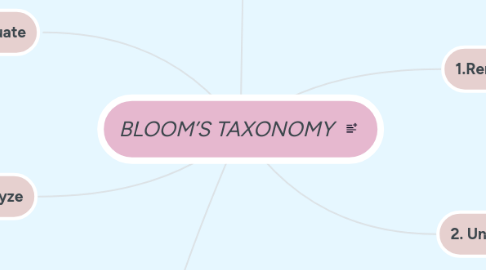BLOOM’S TAXONOMY
by Fernanda Suárez


1. 3. Apply
1.1. Apply involves using procedures to perform exercises or solve problems. Thus, Apply is closely linked with Procedural knowledge The Apply category consists of two cognitive processes: executing – when the task is an exercise (familiar) – and implementing – when the task is a problem (unfamiliar).
1.1.1. Executing Implementing
2. 4. Analyze
2.1. Analyze involves breaking material into its constituent parts and determining how the parts are related to one another and to an overall structure. This process category includes the cognitive processes of differentiating, organizing, and attributing.
2.1.1. Differentiating Organizing Attributing
3. 5. Evaluate
3.1. lt must be emphasized that not all judgments are evaluative. Most of the cognitive processes, in fact, require some form of judgment. What most clearly differentiates Evaluate as defined here from other judgments made by students is the use of standards of performance with clearly defined criteria.
3.1.1. Checking Critiquing
4. 1.Remembering
4.1. Remembering involves retrieving relevant knowledge from long-term memory. Remembering knowledge is integrated within the larger task of constructing new knowled.ge or solving new problems
4.1.1. Recognizing Recalling
5. 2. Understanding
5.1. Students understand when they build connections between the "new" knowledge to be gained and their prior knowledge. More specifically, the incoming knowledge is integrated with existing schemas and cognitive frameworks
5.1.1. Interpreting Exemplifying Classifying Summarizing Inferring Comparing Explaining
6. 6. Create
6.1. creativity is the production of unusual products, often as a result of some special skill. Create, as used here, however, although it includes objectives that call for unique production, also refers to objectives calling for production that all students can and will do.
6.1.1. Generating Planning Producing
